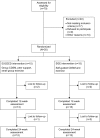A randomized trial of individual versus group-format exercise and self-management in individuals with Parkinson's disease and comorbid depression
- PMID: 28579759
- PMCID: PMC5449131
- DOI: 10.2147/PPA.S135551
A randomized trial of individual versus group-format exercise and self-management in individuals with Parkinson's disease and comorbid depression
Abstract
Background: Depression is common in people with Parkinson's disease (PD), and exercise is known to improve depression and PD. However, lack of motivation and low self-efficacy can make exercise difficult for people with PD and comorbid depression (PD-Dep). A combined group exercise and chronic disease self-management (CDSM) program may improve the likeli-hood that individuals will engage in exercise and will show a reduction in depression symptoms. The purpose of this study was to compare changes in depression in PD-Dep between individual versus group exercise plus CDSM and to examine participant adherence and perception of the interventions.
Methods: Participants (N=30) were randomized to either Enhanced EXerCisE thErapy for PD (EXCEED; group CDSM and exercise) or self-guided CDSM plus exercise. Outcomes were change in depression assessed with the Montgomery-Asberg Depression Rating Scale (MADRS), cognition, apathy, anxiety, sleep, quality of life, motor function, self-efficacy, and patient satisfaction.
Results: Both groups showed significant improvement in MADRS (P<0.001) with no significant group difference. Individuals in EXCEED group enjoyed the group dynamics but noted difficulty with the fixed-time sessions.
Conclusion: Both group CDSM plus exercise and self-guided CDSM plus exercise can improve depression in PD-Dep. These findings suggest that development of a remotely delivered group-based CDSM format plus manualized exercise program could be useful for this population.
Keywords: community-based research; mental health; physical activity; rehabilitation.
Conflict of interest statement
Disclosure MS has research grants from Pfizer, Merck, Alkermes, Janssen, Reuter Foundation, Woodruff Foundation, Reinberger Foundation, National Institute of Health (NIH), and Centers for Disease Control (CDC). She is a consultant to Bracket, Otsuka, Pfizer, Neurocrine, and Supernus, and has received royalties from Springer Press, Johns Hopkins University Press, Oxford Press, UpToDate, and Lexicomp. EM Walter is a consultant to US WorldMeds and Teva. BLW has research grants from NIH/NINDS, Teva Pharmaceuticals, UCB, Inc., Medtronic, and US WorldMeds. He is a consultant to Teva and Medtronic and is on the speaker’s bureau for Teva, Medtronic, US WorldMeds, and UCB, Inc. The other authors report no conflicts of interest in this work.
Figures
References
-
- Kowal SL, Dall TM, Chakrabarti R, Storm MV, Jain A. The current and projected economic burden of Parkinson’s disease in the United States. Mov Disord. 2013;28(3):311–318. - PubMed
-
- Jankovic J. Parkinson’s disease: clinical features and diagnosis. J Neurol Neurosurg Psychiatry. 2008;79(4):368–376. - PubMed
-
- Munneke M, Nijkrake MJ, Keus SH, et al. Efficacy of community-based physiotherapy networks for patients with Parkinson’s disease: a cluster-randomised trial. Lancet Neurol. 2010;9(1):46–54. - PubMed
-
- Yang S, Sajatovic M, Walter BL. Psychosocial interventions for depression and anxiety in Parkinson’s disease. J Geriatr Psychiatry Neurol. 2012;25(2):113–121. - PubMed
Grants and funding
LinkOut - more resources
Full Text Sources
Other Literature Sources


